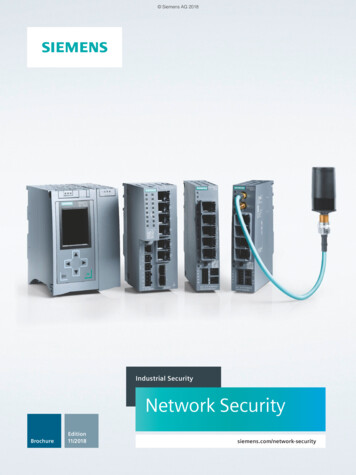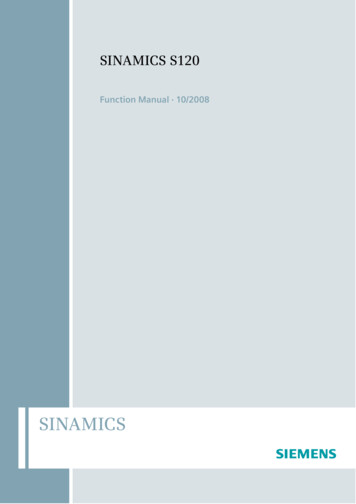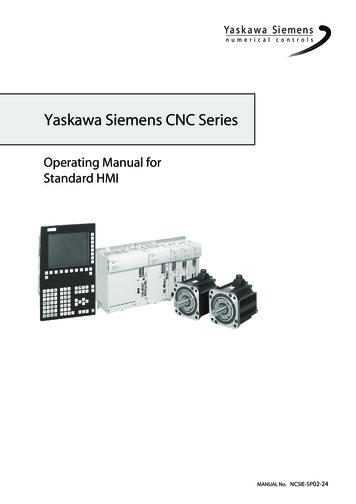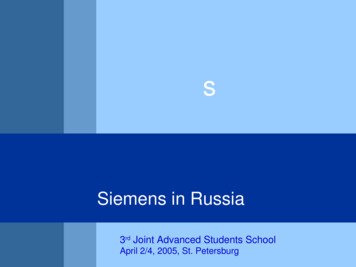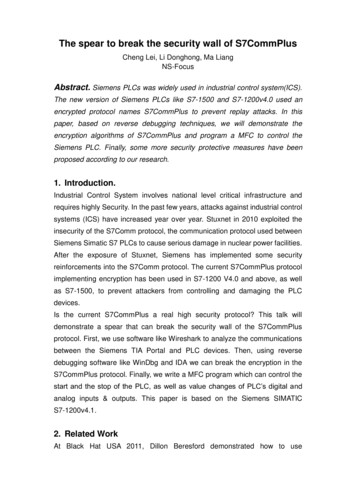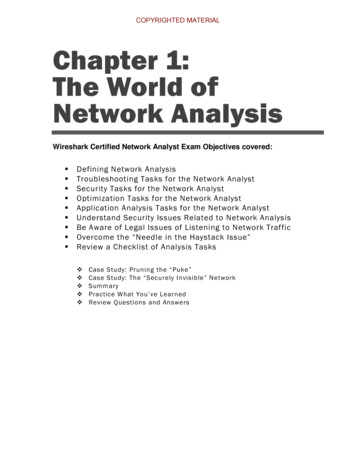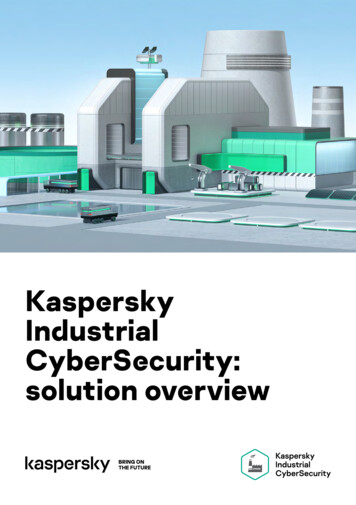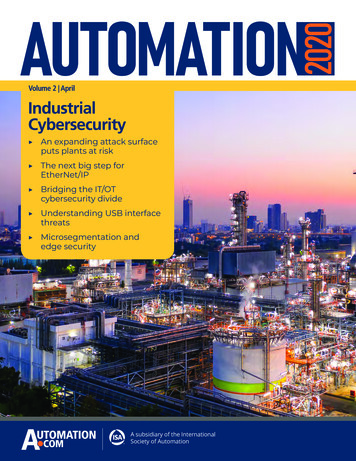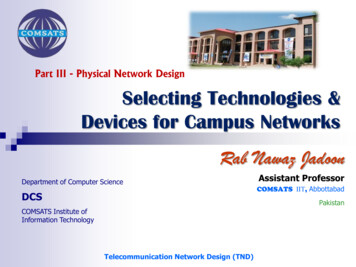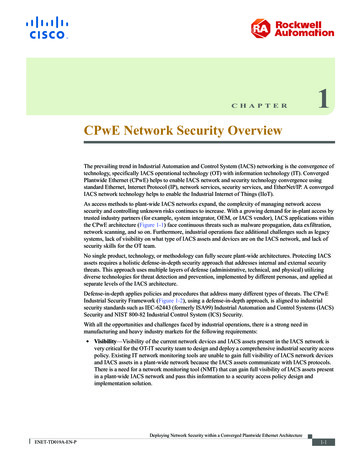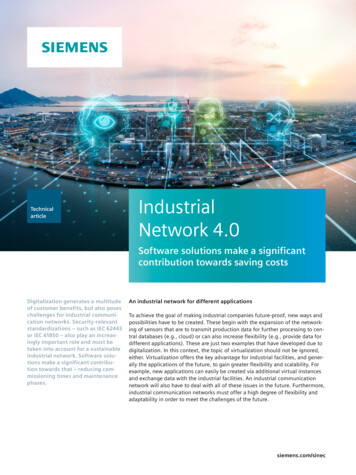
Transcription
TechnicalarticleFachartikelIndustrialNetwork 4.0Software solutions make a significantcontribution towards saving costsDigitalization generates a multitudeof customer benefits, but also poseschallenges for industrial communication networks. Security-relevantstandardizations – such as IEC 62443or IEC 61850 – also play an increasingly important role and must betaken into account for a sustainableindustrial network. Software solutions make a significant contribution towards that – reducing commissioning times and maintenancephases.An industrial network for different applicationsTo achieve the goal of making industrial companies future-proof, new ways andpossibilities have to be created. These begin with the expansion of the networking of sensors that are to transmit production data for further processing to central databases (e.g., cloud) or can also increase flexibility (e.g., provide data fordifferent applications). These are just two examples that have developed due todigitalization. In this context, the topic of virtualization should not be ignored,either. Virtualization offers the key advantage for industrial facilities, and generally the applications of the future, to gain greater flexibility and scalability. Forexample, new applications can easily be created via additional virtual instancesand exchange data with the industrial facilities. An industrial communicationnetwork will also have to deal with all of these issues in the future. Furthermore,industrial communication networks must offer a high degree of flexibility andadaptability in order to meet the challenges of the future.siemens.com/sinec
Collaboration between IT and OT worlds – lowering investment costs for industrial facilities.Compliance with IEC standardsEspecially in industrial communication networks, though,there are additional requirements. There are additionalstandards existing in various industries that must beadhered to (such as IEC 61158 / IEC 62443 in the field ofmachine construction and manufacturing and processindustries, or IEC 61850 in electrical switchgear). Thesestandards also include specifications that in particularaffect the definition of the network architecture. Take forinstance the IEC 62443 standard, where the topic of strictnetwork separation between the corporate network (ITnetwork) and the production network (Operational Technology – OT network) is described. Another example isthe IEC 61850 specification, which defines correspondingcommunication protocols (such as MMS for data communication and GOOSE telegrams).All of these aspects need to be considered when creatinga network infrastructure for an industrial communicationnetwork. In addition, the topic of “security” – i.e., networksecurity – must of course not be disregarded. In manycases, however, it is neglected as it is considered to be toocumbersome and too complicated. But there are reasonswhy such security-related approaches exist – includinguser management, encrypted data protocols, and secureauthentication. Paramount to all of these security requirements is primarily the protection of industrial networksagainst unauthorized access and manipulation.
Collaboration between IT and OT worldsAnother point that must be taken into account in industrialcommunication networks pertains to the central “companypolicies”. Company policies are rules and specifications(e.g., certain ports have to be blocked, passwords mustmeet certain security features) that are set for the companyby the central network administrators and that must alsobe taken into account in the industrial communication network. Coordination with the company’s network administrators is necessary for this to jointly determine the responsibility for the network transitions between the IT and OTnetworks. Security is a success factor for digitalization notto be underestimated.Once the network concept has been devised, it is timeto think about what software and hardware products touse. There are many manufacturers on the market whoseproduct range extends from hardware components (e.g.,switches, routers, modems, firewalls, wireless LAN accesspoints) all the way to software products (e.g., networkmanagement systems – such as SINEC NMS for managingthe hardware, RADIUS servers for device authentication inthe network, or syslog servers for transparency of eventsoccurring in the network).The time and effort involved in testing is sometimes verycomplex and involves a lot of manual labor. There is anincreasing desire here for such machines or facilities to beautomatically tested and documented utilizing an acceptance protocol. In addition, there is the need for scalabilityin the software products: So that additional machines canbe integrated into ongoing operations without great effort.Another important point is the ability to obtain a completeinventory list of all devices at the push of a button, i.e., acentral overview of which components (e.g., network components and end devices) are installed including their respective firmware version. This not only applies to a singlemanufacturer, but to all components in the industrial network across manufacturers.The topic of central firmware management must also betaken into account. With an overview of which componentsrun which firmware version, unauthorized firmware versions used in industrial facilities can be quickly identifiedas well as devices that need to be upgraded to the currentfirmware version.SINEC NMS is flexibly scalable and can depict industrialnetworks of all sizes, manage them centrally, and configurethem based on rules – including security-related aspects.Regarding the hardware, it bears mentioning that in themeantime all manufacturers are offering a comprehensiveportfolio with very extensive feature sets. This means thatthe hardware products hardly differ functionally from oneanother. Rather, the software solutions will make the difference in the future.Network management for industrial networksThe simplicity of operation (reduction of network complexity) and the lowering of operating costs (operational expenditures) play roles that should not be underestimated, especially when it comes to managing networks. Not only isthe network itself of importance for industrial communication networks, but especially the end devices are very important. Only in concert with the end devices can a complete overview of the industrial facilities be obtained, anda premature failure be recognized and prevented thanks tocorrelated information. This is achieved by correlating thenetwork information together with the end device information in the analysis.Especially in industrial applications, however, there aremany other aspects that are very important in this inter action. For one thing, industrial facilities grow again andagain due to the installation of new machines. Consequently, these new machines must also be integrated andtested: Has the machine been configured in accordancewith the specifications (e.g., IP address, device name,correct firmware version)?With SINEC NMS – increasing productivity of industrial facilities.
But already a phase earlier, i.e., before the ongoing operation of an industrial network, the requirements are changing as networks become increasingly complex due to theadvancing digitalization. For instance, the basic initialization of devices in industrial facilities is becoming more andmore of a challenge because the initially required basicsettings are made individually for each new device – whichis cumbersome. This includes, e.g., the assignment of IPaddress and device name as well as activation and deactivation of SNMP or services (such as DHCP client, NTP client).Here, one desires small, compact helper tools that are intuitive to use and with which one can quickly and simultaneously commission several devices in parallel.An equally valuable point from a security perspective is totrack the events in industrial facilities in order to identifypossible irregularities in the industrial networks. For this,“syslog messages” are primarily used. Each componentsends its events (e.g., User A has logged in to Device Bat dd.mm.yyyy hh:mm:ss) to a central syslog server. Allevents are saved there and can be used for further analysis.In addition, certain network services are consistently required for a holistic network approach throughout theentire life cycle for the maintenance and upkeep of thenetwork. A central infrastructure server that combinesdifferent services in one instance would be ideal here.The SINEC PNI (Primary Network Initialization) tool simplifies and reduces the time required for the initial commissioning of network components in industrial networks.SINEC INS (Infrastructure Network Services) simplifies theinstallation and management of all services necessary in anindustrial network in a single tool.Quick and simple installation of all necessary servicesIn today’s security concepts, a secure network access playsan increasingly important role. When it comes to access tothe industrial network, it should be made sure which applications and devices are to be given access at the industrialnetwork. Access by applications and devices can be protec ted via firewalls between the network segments, or thespecifications from the IEEE 802.1X standard can be used toregulate access by devices directly in the industrial networks.SINEC INS includes all services necessary in a single user interface – reducing the effort for installation and management.
ConclusionWith the new SINEC software family, Siemens has the right answer to all ofthese topics in the different phases centered around the industrial network.From initial commissioning of new devices to monitoring and managementof an increasingly complex network – including all software services necessary for an efficient network operation. Here, it is particularly convenientthat the products are scalable and interact with each other. This makes asignificant contribution towards reducing OPEX (e.g., reduced maintenancecosts) and readies industrial companies for the digital future.Security informationIn order to protect plants, systems, machines andnetworks against cyber threats, it is necessary toimplement – and continuously maintain – a holistic, state-of-the-art industrial security concept.Siemens’ products and solutions constitute oneelement of such a concept. For additional information on industrial security measures that may beimplemented, please lished bySiemens AGDigital IndustriesProcess AutomationÖstliche Rheinbrückenstr. 5076187 Karlsruhe, GermanyPDFTechnical articleDI-PA-1920-14PDF 0420 5 EnProduced in Germany Siemens 2020Subject to changes and errors. The informationgiven in this document only contains generaldescriptions and/or performance features whichmay not always specifically reflect those described,or which may undergo modification in the courseof further development of the products. The requested performance features are binding onlywhen they are expressly agreed upon in the concluded contract.All product designations may be trademarks orproduct names of Siemens AG or supplier com panies whose use by third parties for their ownpurposes could violate the rights of the owners.siemens.com/sinec
Security-relevant standardizations such as IEC 62443 or IEC 61850 also play an increasingly important role and m ust be taken into account for a sustainable industrial network. SINEC software solutions make a significant contribution towards
